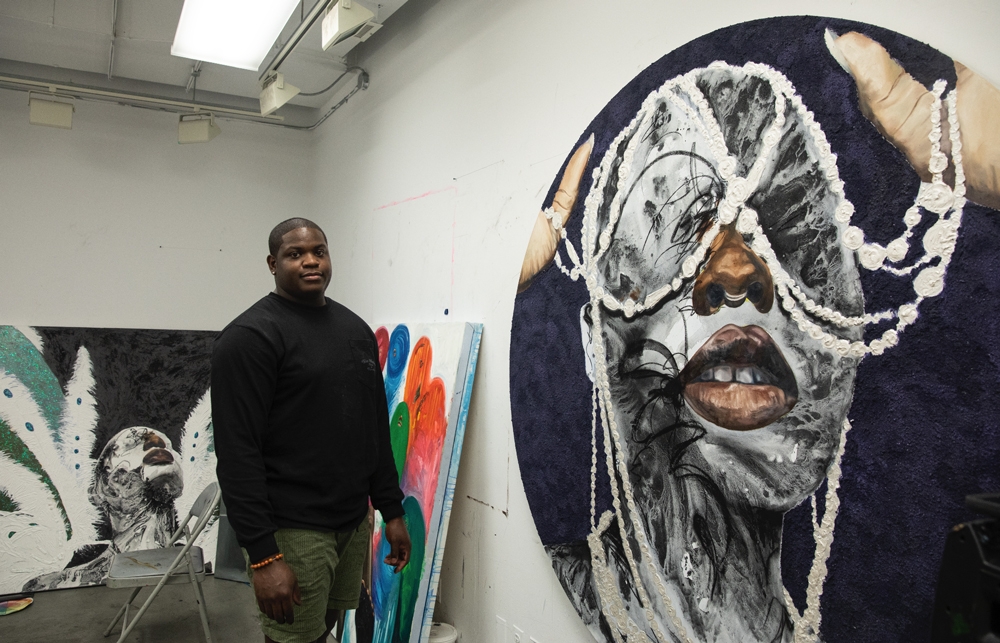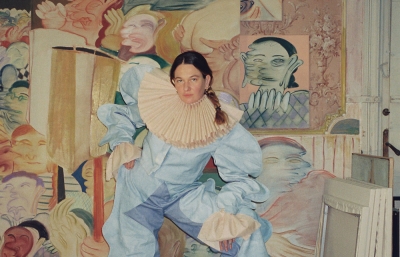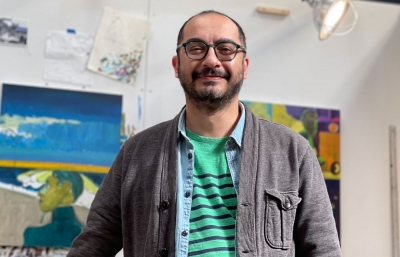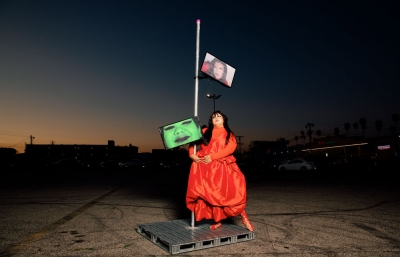Khari Turner
The Light Between Oceans
Interview by Doug Gillen and Evan Pricco // Portrait by Laura June Kirsch
“If I met my ancestors at the edge of the ocean, would I bring flowers?” What a natural notion to posit, a sentiment to be etched in stone and passed down through the ages. When Milwaukee-born, NYC-based painter Khari Turner considered this simple, rhetorical question during our interview, in what was personally and professionally a light-switch moment while musing about his painting, a shared clarity arrived. It’s true, I’ve thought about this concept over and over again: If I met my ancestors at the edge of the ocean, would I bring flowers? How would that appear? What does a meeting of bodies of water even look like?
But that’s just one aspect of his journey. A botched financial aid mishap followed by a scholarship and unlikely gig as cheerleader at Austin Peay State University, working as one of those incredible high-flying stunt slam dunkers with the Milwaukee Bucks, and then onward to NYC and Columbia, each experience hydro-powered into a flourishing art career, yet another unique passage Turner has traversed over the course of a young life. Over the past few years, he has explored the properties of water as means of transportation, navigation, and life force, as well as art material, creating some of the most powerful paintings we have seen. While the first encounter is literally and figuratively stunning, a deep dive discloses that Turner is immersed in a personal, universal quest, exploring family, names, identity and home. —Evan Pricco

Doug Gillen: What’s your idea of Milwaukee art?
Khari Turner: Oh my goodness. It's really hard, because the thing is that funding that goes to Milwaukee art is usually always the big graphic design-style murals. So it depends, because there's so many other people who are doing work, but again they're like a lot of people in the inner city who are making their own creations and doing graffiti art and all types of other stuff. A lot of my art at the beginning was graffiti art because that was everywhere.
The Milwaukee Museum makes it so it's like you get the opportunity to see all this great stuff, but again, that's by the lakefront. It's where really all of the businesses are, where all the more wealthy areas are. To get out there, you really have to make your way that way, so it just depends.
Evan Pricco: When you say that it looked like graffiti, were you actually going out and doing graffiti?
No! Well, yes and no. I was terrified of going out and somebody stopping me as I'm painting a wall and I’ve got a backpack full of supplies. So, what I would do is just find random loose boards of wood that nobody cared about, and then I would spray paint those because I was, like, no one's going to stop me for this. That's what I did.
DG: What was your entry point into art? Was it through these non-graffiti, graffiti-type spray-painted wooden panels, or was it something else?
No. My grandfather was a draftsman for this pump company, so he was drawing constantly. Even in his younger years, he drew all the time. I basically spent a lot of time with my grandparents, and he had a woodshop downstairs in his basement. He did all these drawings, had art all over the place.
I knew he could draw, so he would draw stuff for me. And then I would basically try to copy it. I had posters of planes. He'd draw a plane. I'd draw a plane. And then, after a while, I basically was in school and people in school would draw. I was like, oh, I got to learn how to do that. Really, it was like school with my grandfather at this young age, so all this art surrounded me right in my grandparents' house.

DG: When did you realize that this was the path you were going to follow?
Oh, really early on. I knew art was going to be my whole setup. I just didn't know what kind of art or what way to make art work. So, at first, I was like, maybe I can be a courtroom sketch artist or police sketch artist. Maybe I can work for Pixar. I didn't know what I wanted to do. But making actual paintings and whatnot, and making work off that, was definitely not a reality. It didn't seem real, because I didn't see anybody else doing it. I was like, there's no jobs for that. But I knew I was going to do something with art regardless. It was either going to be this or a chef.
EP: Water is a big part of what you're doing right now. When did that start? Is that an element you started to work with while in school in Tennessee, or has that evolved over the last year and a half while in NYC at Columbia?
Pretty much over the last year and a half. This idea of the noses and the lips that I've been doing, that started in Tennessee, and that started because of this idea of social justice. When I first started doing all that, all my research for my senior show, I was like, all right, I know that privatized prisons and the funding to put bodies into these prisons is a really big issue, because it creates a situation that necessitates people occupying prisons. Okay, well, then, now we're going to start getting people in the prisons. How do you do that? Well, you find petty crimes, three strikes, all of these long sentences for stuff that's absolutely not something people should be going to jail for. And then, you've filled up those prisons, and you make money off of that. But it becomes a question of how do you change a situation like that?
Either way, when I was doing all that research, I found that people with wider noses, thicker lips, and darker skin got longer prison sentences on death row; which obviously makes sense, like the percentage of black bodies in prison connected to the percentage of black bodies in the United States is drastically different. It was one thing to think about, that just my nose and my lips and my skin could be the reason I get a longer sentence. So then, I started just focusing on that, and eventually it changed into these aspects of inspiration for the work and thinking about these as markers of my ethnic identity. Understanding that there's a whole history behind it, that's where the water came from.
I started thinking about relationships to segregated pools, the connection to my identity and water. Considering growing up next to Lake Michigan, I was always by water, and to think that there were so many people who would be by water but who could not swim. My grandmother couldn't swim, so she decided it was very important that her grandchildren would learn. My mom really can't swim either, but she can get around. She's in the pool. She's not drowning, but she's not really swimming.

DG: How did you start to incorporate water into your work?
It's interesting. Last year in July, I did this residency at Iris Project, which is next to Venice Beach. And that's where it started. Water was already in the work, but not ocean water, specifically, until I actually went to the ocean. And so, when I saw it, contextually, it made sense. I'm talking about all these things, about Black identity and connections to the ocean. I thought, “Add ocean water to the work.”
But one thing that I didn't think of was the interaction between the paint and the actual substance of the water. Because of the salt, because of the minerals, because of everything, the paint actually collected those particles that were in the water and then transformed the way the paint and actual water separated. So, the paint drying and the paint mixing created a different surface than I was really working on.
That's what made me go, okay, I can definitely do something with this. Let me make the water a little bit more specific and think about, like, okay, what water am I using? What kind of historical context can I add to the water? What am I doing? And so, that's when I started using the water here in Manhattan, thinking about the ports that slave ships would come through and then, okay, if I'm using the water from these ports that are the same water slave ships came through, I’m adding context more and more to each thing that I'm doing in the work.
DG: That's mad. I like these layers.
When I was younger, I thought rendering was the go-to. In school, they're always like, "All right, this is how you make a box and make a box look like a box." So, I thought that rendering was the end-all, be-all. Like, if I can make something look like something, then I got it. That's it. There's no more art after that.
Then I got to that point where I needed something else—a whole bunch of something else—because I got to the point where I was making work that looked like the person that possessed these different things, but I thought, this isn't doing it. Then I did all the work where I would paint scenes of protest, and I was like, okay, this is it… and then, this is still not it.
The abstraction came in because there needs to be disconnect between the person, specifically who it is, and the viewer. I kept running into problems where I would want to have a conversation around topics, but people would be more interested in who the painting was and my connection to that person. To me, I don't care about that part of the conversation. People were like, "Oh, is this a friend?" Like, "Is this a cousin?" I was like, "It doesn't matter specifically who he is or who this person is! This is about what's happening in the scene."

EP: So, in a sense, when you went more abstract, you were actually able to communicate a clearer, more universal message?
Yeah, it needed to happen that way because I kept getting stuck. And the thing is, being in Tennessee, I had a lot of white classmates who did not feel comfortable talking about any type of issues, especially considering all the stuff that was happening with Freddie Gray. With everybody in these conversations, it felt as if they were trying to link to something completely opposite to what I was having a conversation about. That wasn’t what I intended, so trying just straight abstraction wasn't going to cut it, but if I could figure out a way to combine the two to allow for an entry into the work in multiple ways in order to finally arrive at certain different points, then that was the method to do it.
Oil painting was just the way I was taught, or at least the way I had learned. Nobody taught me, but I really liked painting in this medium. Oil painting was the go-to every time. Plus, it gives a lusciousness to the skin tones that I'm working on and treats the figure a lot more carefully. I feel like when I do these parts of Black bodies, with diligence, I can make sure they are rendered well and with care.
DG: If eyes are the window to the soul, what are the nose and the mouth?
The airways. The thing is that you can actually see the water in my work. What I figured out early, what I really thought about for a long time, is that my artwork is made of bodies of water, of people who are composed of water, trying to communicate to actual humans who are made of about 70-80% of water. So, we all are bodies of water, which is a different connection. It's like this body of water next to my body of water, and how does the water between the both of us become a conversation? That's when everything changed, because I perceive people as the ocean. I'm also thinking about the connection between myself and any other person outside of skin tone, which is funny, because it's a lot about skin tone, but that's the second entry or the counter-entry into the work.
Some people enter the work through the facial features, but then other people enter the work through the abstraction. And I wanted it to be that way because I don't want it to be any type of situation where there's a barrier between any person who’s an audience member or who's viewing the piece. And so, you can either go, "I really liked that abstraction," or then go, "Oh, I really like the way that these facial features or hands are rendered," and also go, "I really like the way that these facial features are rendered. Oh, and this abstraction with them is interesting." It's a two-way street I was really focused on making possible through different avenues. Maybe no eyes attached to the body, but the connection between this body of water and your body as full of water is supposed to be the new connection.

EP: Regarding this experimental phase you were going through, and this may be an unfair question, but I wonder when you took a step back from the work and realized, “I found it.”
There were two moments. The first was during quarantine I had this really big 48 x 60” piece on paper. I was doing a bunch of pieces on paper when quarantine happened because I couldn't get supplies. So, I did this one on paper. People connected it to a coronavirus head, because it has these multiple branches with these puffs coming out at the end—though it was just a reference picture that I was using of this African hairstyle. And so, it was really dope for me. When I finished, as I was standing in front of it, I was like,”Oh yeah, this is it. I can make this work for forever.” This is what I want.
The second one is this piece called Meeting of Two Oceans that I did right in Venice. It was composed of one section of ocean water and then another section of ocean water with different pigments that met in the middle but did not mix. The idea was if I was to go to the beach and try to meet an ancestor at the edge of the ocean, would I bring flowers? And then, I painted or drew flowers into the piece. I thought, this is the piece. This is the one. This is fantastic.
DG: That turn of phrase, “If I met my ancestors at the edge of the ocean, would I bring flowers”...? Is that a reference too, or is it just pure you?
No, it's just pure me. A lot of my time before going back to school I was looking at slam poetry. I have a lot of friends who are slam poets, and I have a bone for poetry. A lot of my titles are Langston Hughes poem references. And so, there's a lot from me.
I was the kid who sat next to the water, and thoughts just came. Things like that just made sense in the way where it's a mix of the real and fantastic, which is kind of the same way that I paint; there are parts that are realistic and then parts of that are just abstract ideas that potentially could happen.
It's not always at the beginning of the thought. Sometimes I'll be in the middle of a painting, and then have this thought. If you ever see a picture of two oceans meeting, they mix at the bottom, but there's a clear sign they hit each other. So, to me, if I was in that position, and I was an ocean… my body is a body of water meeting an ocean of a body of water, and memory is in water. So to think of an ancestor in that water, to think of us meeting, wow, what would that be like?
Khari Turner’s solo show with Ross-Sutton Gallery in NYC will be on view through July 10–August 7, 2021






